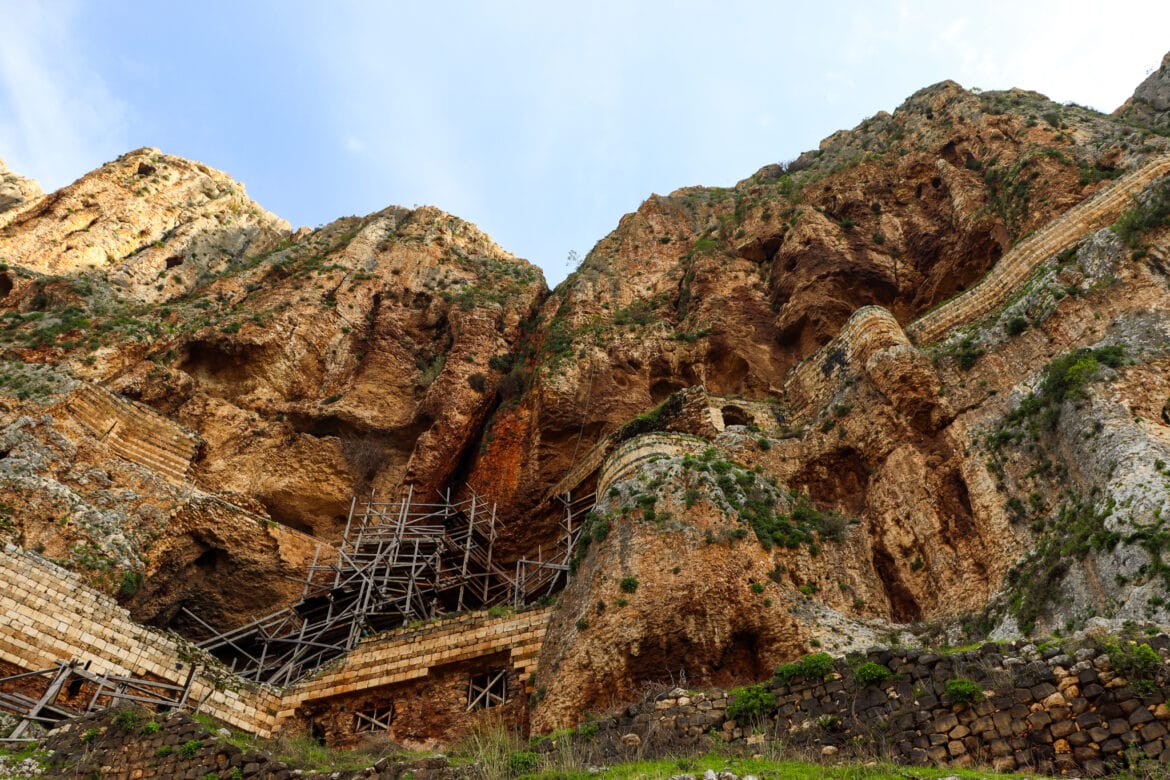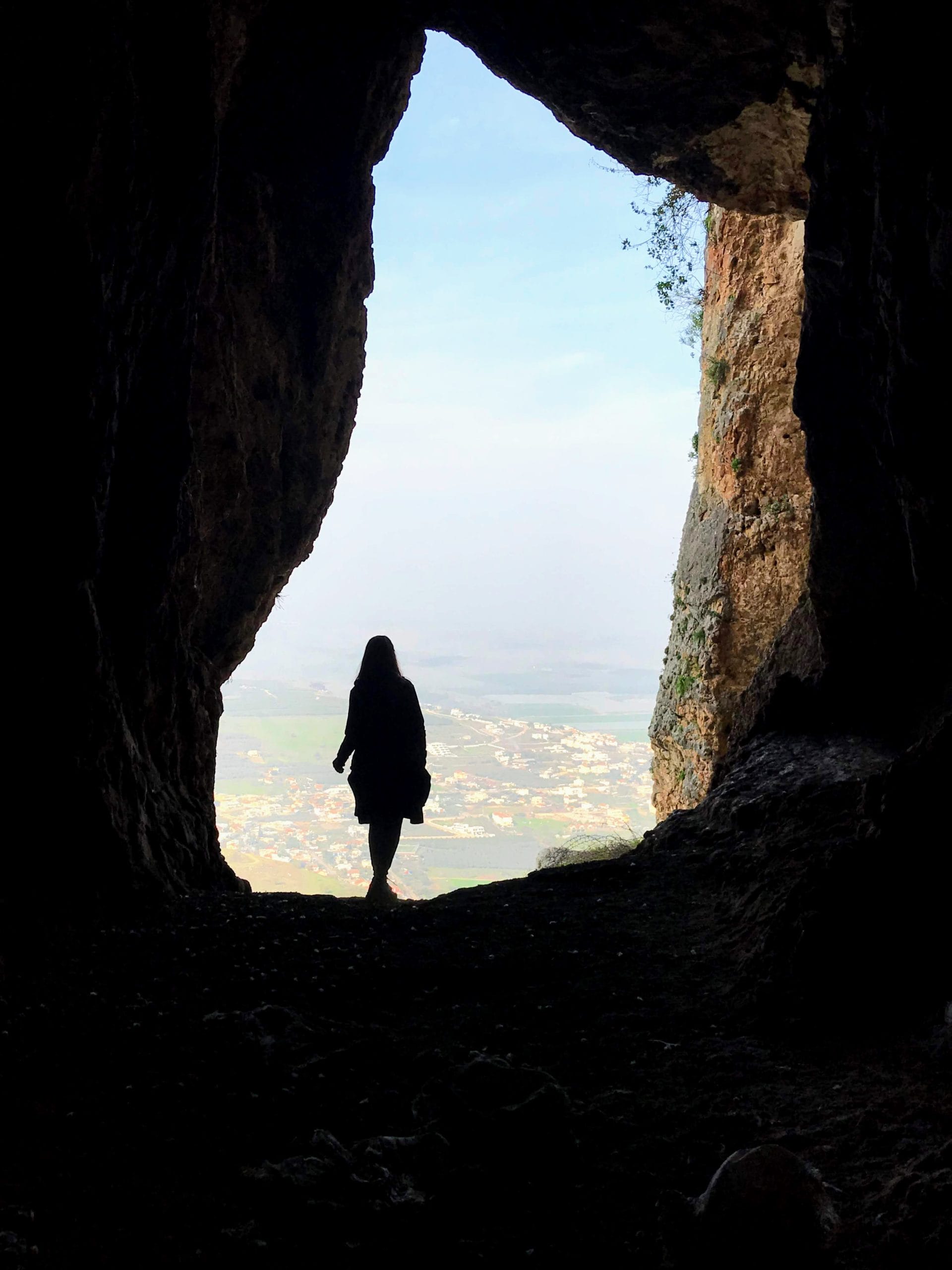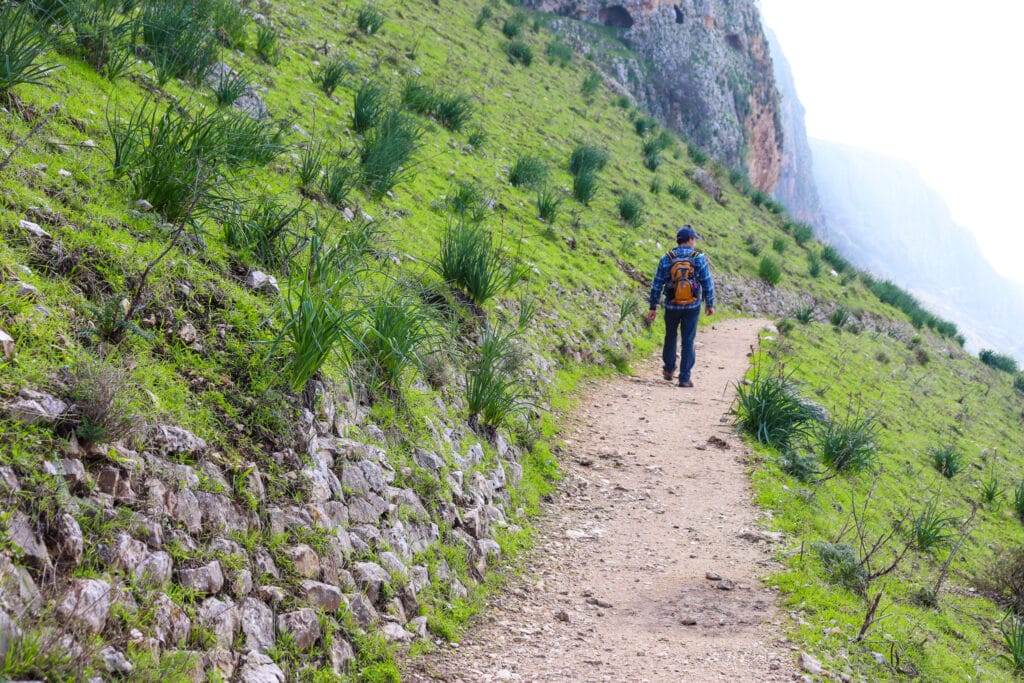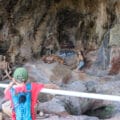
| Trail Map | Terrain View | |
| Distance: 4km | Time: 2-3 hours | Difficulty: Moderate |
| Ascent: 565m |
Click here to go straight to hike notes.
Arbel Mountain – it’s a popular spot in the Galilee that’s known for its jagged cliff and stunning views. But do you really know Mount Arbel?
I definitely did not – until a few days ago, when I climbed down Mount Arbel and back up again, discovering all sorts of surprises along the way.
Arbel is more than just a fancy mountainside. The cliffs are cool, and very fun to climb. And the views are amazing, at least on a clear day.
But there’s a lot more to explore at Mount Arbel. There’s nature, for one: Arbel has its own little ecosystem, with animals and flowers that you can always catch a glimpse of. More importantly, Mount Arbel has tons of history.
From caves to fortresses, there are many historical places to explore on the cliffs of Arbel. Even though I’m more of a nature lover than an artifacts gal, I found myself drawn into the story of the people that once lived on Mount Arbel. I fell in love with the fortress carved into the side of the cliff.

I have never seen anything quite like it in Israel.
As if the beauty, history, and discovery weren’t enough, we also got to climb the side of the mountain, on a series of ladders and handholds that make a challenging ascent accessible and safe.
All in all, Arbel Mountain was a fantastic hike. Here’s how we hiked this 4 kilometer loop trail at Mount Arbel:
Ho Hum, Nothing New Here
Last time we visited Arbel, we went on the short loop trail with our kids. It was beautiful. The views out to the Kinneret were probably the best I’ve ever seen. But the hike, itself, was more relaxing than exciting.
So, this time, I was hoping for something really intense. I had figured we would start at the foot of Mount Arbel and climb to the top, then maybe climb back down along another route.

But after a series of miscommunications, we ended up starting our trail back at the top of Arbel. And the plan for the day wasn’t to climb up the entire mountain. Rather, we would be covering about half of its height on the side of the cliff.
As we began, I was a bit disappointed. It was a hazy day, so even the views out to the Kinneret were less thrilling than usual. We started by tackling the descent, climbing down the side of the cliff on hand holds. It wasn’t very hard. And I didn’t have a lot of hope for this new Arbel hike.
Cows and Chamomile Tea
We passed by some rock badgers hanging out on the side of the cliff. And then we reached an open area, with large rocks to sit on. On one side, some cows stood grazing on the cliffs. Tall flowers sprung up in between the rocks.


It seemed like a good a place as any to stop for an early break. The sun was shining and a cool winter breeze was in the air. It was time to slow down and appreciate the fact that even if this hike wasn’t what I expected, at least we were outdoors in a beautiful place on a gorgeous day.
We poured chamomile tea from our thermos and sat there watching the cows: large, lumbering animals performing uncharacteristic feats of grace as they scaled jagged rocks to graze on the side of the cliff.

A few deep breaths and warm cups of tea later, we were ready to see the rest of Arbel.
Where Everything Gets Much, Much Better
I thought we were almost done with this hike. But from here on in, the trail’s excitement factor soared.
First, we reached some little caves carved into the side of the mountain. They were small and dome shaped. The scene looked almost looked like an oversized columbarium (man-made carrier pigeon housing).

In fact, these caves were used during the time of the Second Temple. During times of unrest, rebels fled with their families to Arbel Mountain, hiding out in these teeny tiny caves for months at a time.
Signs stood near the site, printed with excerpts from Josephus, written about these very caves.
The Coolest Israeli Fortress I’ve Ever Seen
Past the caves, a bit further along the trail, a humongous fortress suddenly appeared out of nowhere, carved into the side of the mountain. It was incredible to see from down below. And at first glance, it looked like all we were going to be able to do was look at it from the outside.
But as we approached, it became clear that the trail continued inside of the fortress.

This was no ordinary set of ruins, as one typically finds in Israel. The Arbel fortress is actually in the process of being restored, and visitors can tour through several levels of rooms, each with their own purpose.
We climbed up steps, up ladders, from one room to the next. There were signs, explaining the use of each room.
Of course, there was the traditional mikvah (ritual bath), clearly identifying this site as a fortress for Jewish rebels. As opposed to regular mikvaot, this one was built a few levels up hanging above ground.

It impressed us to think about the fact that even during times of fighting for survival, these ancient Israelites clung fast to their religious practices, going as far as gathering rainwater to immerse in.
As we climbed to the top, the fortress became even cooler. We were really able to imagine the Jews who resided here, and how they lived. The best part was the sniper’s hole, a thin slit of a window at the very top of the tower. The gap was perfectly sized for a bow and arrow – and nothing more.
The Fun Isn’t Over
From the fortress, we moved on to explore a nearby cave. It was dark and deep, now home to bats that lived in the shadows. But once, it had been a place for Jewish rebels to hide away.

Further along the trail, we saw more little caves, reminiscent of hobbit holes. Arbel was once the perfect hiding spot for troops and their families who rebelled against the Roman appointed king, Herod. They sought refuge in its cliffs and safety in its crevices.
Until It’s Over
After a few more series of caves, the history lesson came to an end. Up ahead, the trail back up the side of Arbel cliff continued, along solid metal handholds and back up towards the main area of Arbel National Park.

We climbed back up to the top, bringing our five-star hike to an end.
Next time, we’ll tackle Arbel Mountain from the very bottom to its peak. But we’re not sorry that we missed it this time around.
This climb down and around the cliffs of Arbel was more than just a physical feat. It was a fascinating journey through history and nature on uniquely beautiful mountain in the Galilee.


Hikers Notes:
Here’s what you need to know about this hike before you start:
- Arbel is a National Park. That means that you need to pay an entrance fee (or use your Parks Card). There are free maps and facilities on site.
- No dogs allowed.
- Suitable for all seasons.
- During the rainy season, make sure to call the Parks Service and check that Arbel is open before you go. Sometimes they close for several days following a rain storm.
- This hike is great for families! That said, I wouldn’t bring little kids or babies on the trail. The ladders at the beginning and the end could be a bit scary. I recommend from ages 10 and up.
- May not be suitable for those with a fear of heights.
- If you do bring kids, I highly recommend that you purchase the Ranger Book at the beginning. It costs 10 shekel and is full of tons of interesting information about the site for kids. It’s kind of like having your own little tour of the site. Prizes for kids who complete the booklet.
- Trail colors to follow: black, left on red, black back to parking
Don’t forget to read my guide to the navigational features in this post before you hit the trail!
Trail map from Amud Anan.
Questions? Have you taken this trail along the cliffs of Arbel? Let’s hear about it in the comments!







Last year I took a small tour group down the Arbel. A 79 year old fit man was part of it as well as a very stylish lady. It was one of the most beautiful hikes we did. And then I found a Black Arum near the bottom of the hike. Wow. Stunning.
We just took the longest possible hike there yesterday. We (two kids: 10 and 8 yo and me) the black trail from the top, wemt to see the small caves (the fortress is under renovations therefore closed) and turned back to descend on the red trail. I was seriously worried how would we climb back all the way up to the car. We took a lunch break where the two trails meet next to the brook. From there the green trail is really gorgeous and literally a walk in the park. Just jeep in mind that you have to cross the stream on rocks several times so waterproof shoes are beneficial. We just got wet/soaked. Then comes the hard but rewarding part: climbing up. The view is beautiful. Once you get to the top you still have a km and a half walk back to the entrance. This is the longer hike you find on the gan leumi site. It was beautiful but next time I’ll stick to the shorter one.